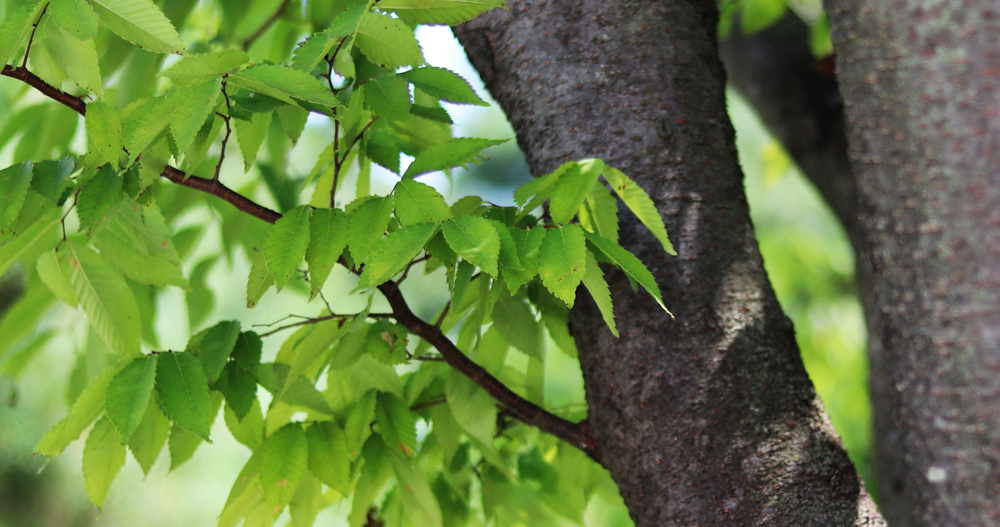Zelkova serrata
Common Name:
Japanese Gray-Bark Elm

General information:
Zelkova is often listed as a replacement for American Elm since it has roughly the same vase shape and grows 90 to 100 feet tall with a 60 to 80 foot spread. Zelkova is massive, with the trunk capable of growing to four feet or more in diameter. It has a moderate growth rate and likes a sunny exposure. Branches are more numerous and smaller in diameter than American Elm. Leaves are 1.5 to 4 inches long, turning a brilliant yellow, orange, or burnt umber in the fall.
This elm is a native of Japan and China and is related to the Ulmus genus, which is the genus of the European and American elms. It is deciduous with small ovate, serrated, pointed leaves and smooth gray bark. It is a vigorous grower and is most often used for broom and group plantings. Root-over- rock plantings are also common. The gray-bark elm is considered by some to be the classic broom style tree.
Family:
Ulmaceae
Lighting:
Full sun to part shade. During summer in southern part of USA, do not expose the tree to direct sun during the heat of the day.
Temperature:
Zones 5 through 8. Make sure the tree has good winter protection.
Watering:
Allow the soil to dry slightly between waterings. Spray the foliage with water daily during the summer.
Feeding:
Feed every 20-30 days with a slow-acting fertilizer during spring and again from late summer through mid-autumn.
If you prefer to use chemical fertilizers, feed every other week using a half- strength solution of a balanced fertilizer such as Peter’s 20-20-20. If the fertilizer you use does not contain trace elements (minors) then you may need to treat with chelated iron a couple times a year.
Pruning and wiring:
The gray-bark elm is usually shaped exclusively by pinching and pruning, but wire can be used. Wiring may be done any time from late spring (after the leaves are set) through mid-autumn. Structural pruning is done in winter so that the tree will lose less sap and so that the branch structure may be more easily seen. The foliage is developed by pinching back the new growth during the growing season. Wait until new shoots have at least 4 sets of leaves, then pinch back to 2 sets of leaves.
To reduce leaf size, healthy trees can be leaf pruned in early summer. All of the leaves are removed, leaving only the leaf stems on the branches. The tree will respond by putting out a second set of leaves, smaller than the first set. Do not leaf prune the same year that the tree is repotted.
To train a tree in the broom style, allow it to grow (keeping the trunk straight) in a large pot or in the ground until the desired trunk girth is achieved. Then cut off the tap root and lop off the trunk above the point where you want the branches to diverge. Allow the branches below this point to grow out some, then prune them back to only a few internodes. Let the branches grow out again. In the spring before the buds open, gather the branches up into a loose broom shape using raffia. The new growth from the base of these branches will then grow outward to fill out the broom shape. Repeat the process of pruning and gathering as necessary to achieve the desired branch structure.
Propagation:
Cuttings, layering.
Repotting:
Repot every 2-3 years in early spring. Prune the roots by up to half their length. If the tree is in a shallow bonsai container, repot every 1-2 years to avoid having the roots push the tree up out of the pot.
This tree is typically potted in a shallow bonsai pot that is either glazed in cool (blue, green, beige) colours or is unglazed in earth tones. Simon and Schuster’s recommends 60% soil, 20% peat, and 20% coarse sand. Rémy Samson recommends 2 parts loam and 1 part coarse sand. Peter Chan recommends 1 part loam, 1 part peat, and 2 parts coarse sand.
Pests and diseases:
Pests:
Pest resistance: long-term health usually not affected by pests.
Diseases:
Normally disease-free as it resists Dutch Elm disease and Elm leaf beetle. Zelkova is subject to canker diseases particularly if the trunk is repeatedly wounded. Avoid wounding and maintain tree health.
Bibliography:
USDA Fact Sheet ST-677
Compiled by Sabrina Caine Edited by Thomas L. Zane
